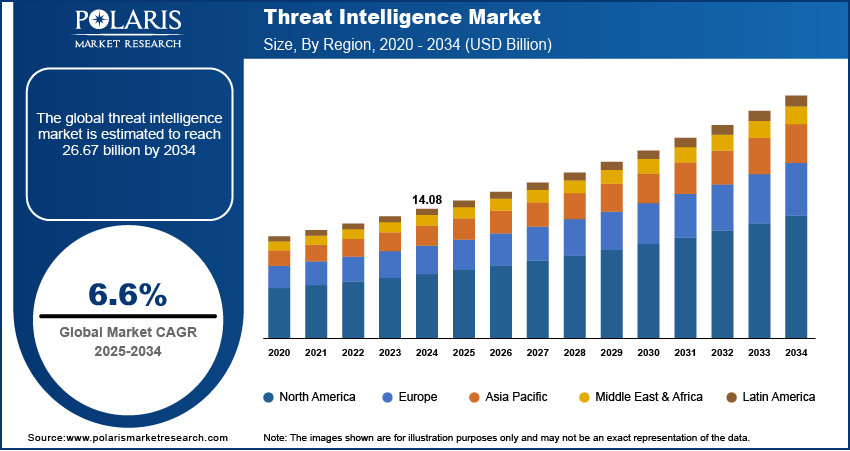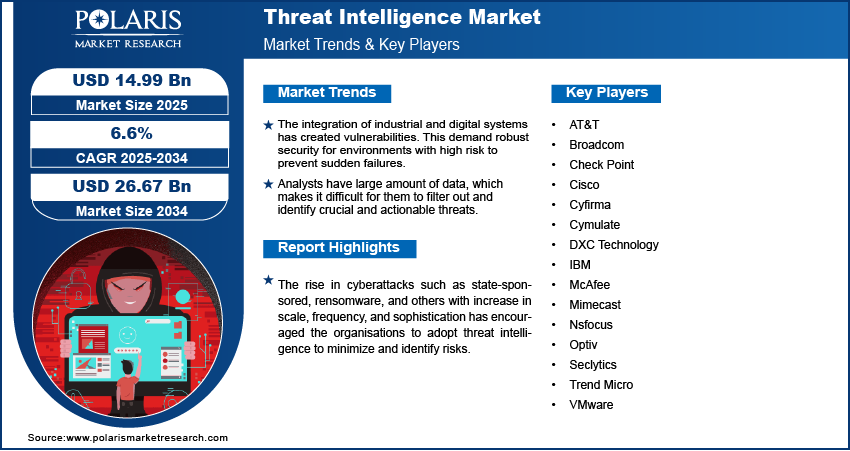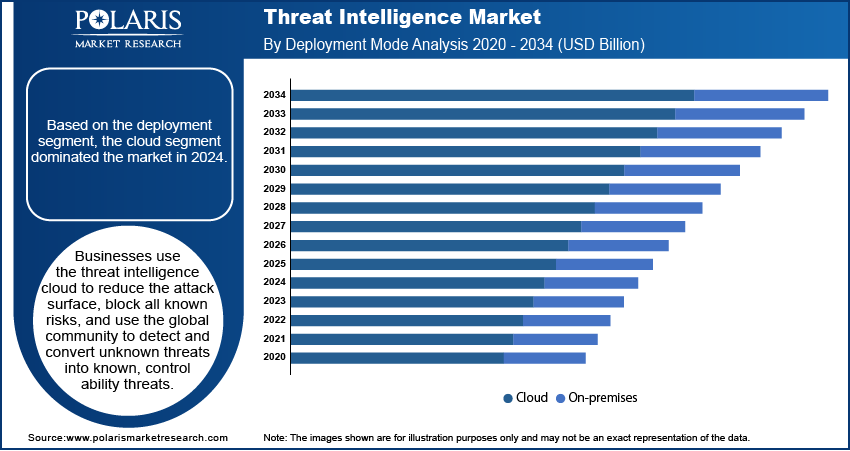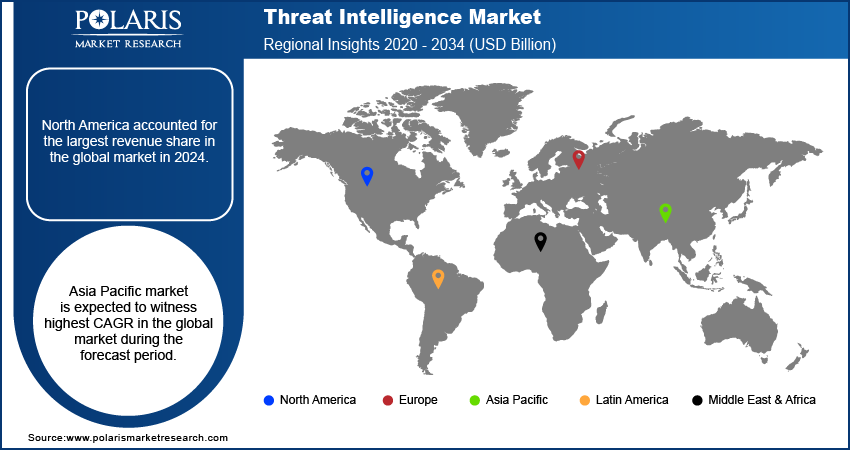
Threat Intelligence Market Share, Size, Trends, Industry Analysis Report
By Component (Solutions, Services); By Deployment Mode; By Application; By Industry Vertical; By Region; Segment Forecast, 2025 - 2034
- Published Date:Sep-2025
- Pages: 146
- Format: PDF
- Report ID: PM2444
- Base Year: 2024
- Historical Data: 2020 - 2023
The global threat intelligence market was valued at USD 14.08 billion in 2024 and is expected to grow at a CAGR of 6.6% from the forecast period. Key factors driving demand include, accretion of digital technologies and industrial systems, R&D investments by governments and enterprises, and rising number of cyber-attacks.
Key Insights
- The cloud segment dominated the market in 2024. This is due to businesses that use the threat intelligence cloud to reduce the attack surface and block all known risks.
- The government, risk, and compliance segment is projected to witness the fastest growth during the forecast period as risk management helps in the identification of essential IT assets and 'critical accesses' that are required for the organization's operation.
- North America accounted for the largest revenue share in 2024. This is due to the rise in the adoption of IoT-enabled devices, and the availability of adequate digital infrastructure.
- Asia Pacific market is expected to witness the highest CAGR in the global market during the forecast period. This is due to organizations' critical data becoming more vulnerable to increased cyberattacks.
Industry Dynamics
- The integration of industrial and digital systems has created vulnerabilities. This demand robust security for environments with high risk to prevent sudden failures.
- The rise in adoption of digital systems in sectors such as healthcare, finance, and others for sophisticated cyberattacks has boosted the need for threat intelligence platforms to manage and minimize risk.
- Analysts have large amount of data, which makes it difficult for them to filter out and identify crucial and actionable threats.
- Expansion of proactive services has boosted demand for these platforms. This creates opportunities for expansion as they predict threats and automate defence, especially for small businesses.
Market Statistics
- 2024 Market Size: USD 14.08 billion
- 2034 Projected Market Size: USD 26.67 billion
- CAGR (2025-2034): 6.6%
- North America: Largest market in 2024

To Understand More About this Research: Request a Free Sample Report
AI Impact on Threat Intelligence Market
- AI helps with automation of large data sets to accelerate identification of threats and patterns for upcoming cyberattacks.
- AI move the focus to predictive insights from reactive analysis by forecasting the attacks before they occur.
- These tools contribute to the advances in threat intelligence by making it more accessible and affordable for small and medium businesses.
The rise in cyberattacks such as state-sponsored, rensomware, and others with increase in scale, frequency, and sophistication has encouraged the organisations to adopt threat intelligence to minimize and identify risks. Threat intelligence industries widely produce beneficial solutions across a wide range of verticals. For instance, in June 2025, Bitsight AI collaborated with Microsoft to contribute to the New Threat Intelligence Briefing Agent which provides timely, tailored cyber threat briefings for security leaders and practitioners. The threat intelligence sector is providing these advances for the organizations that deliver correct analysis, enables predictive capabilities rather than just alerting. These solutions are becoming essential as they provide tailored insights for sectors such as healthcare, finance, and real-estate.
For instance, as per the Center for Strategic and International Studies, in February 2022, Russian hackers attacked accounts of multiple defense contractors and stole sensitive data about the businesses' information on products and their conversations with the stakeholders.
Thus, to deal with cyber fears, retailers have begun to invest heavily in the threat intelligence market to determine the impact of these security and data breaches, allowing them to be predicted and countered. Additionally, there is a high market demand for the e-commerce industry across the globe. The rise in internet users has increased the demand for e-commerce solutions.
The digital transformation is now extended to the E-commerce channel. More connected devices, such as kiosks, Point-of-Sale (POS) terminals, and handheld devices, have made their way into physical stores, all designed to collect and access customer information.
Threat intelligence is the collection and evaluation of information useful in defending an organization against internal and external threats and analyzing that data to detect deceptions to gather accurate and relevant intelligence. However, threat intelligence market solutions necessitate company-wide coverage for smooth and secure operations, resulting in higher infrastructure costs.
Industry Dynamics
Growth Drivers
Digital technologies and industrial systems have merged into a single ecosystem. This expands profitable positions for technologies like M2M communication and the IoT. Industries require secure control systems, particularly for equipment deployed in harsh environments like subsea oil wells or mines. Failure of this equipment operating in such conditions can be disastrous, resulting in significant financial losses and putting the lives of several people near these sites in danger.
Furthermore, the market is being driven by the increased use of next-generation security services in numerous firms and their applicability in varied markets. Most banking institutions have benefited from digital platforms, putting them exposed to cyberattacks. It has sensitive data and information, leaving it vulnerable to hackers.
These organizations demand intelligent solutions to these issues to identify network sources that have been compromised and develop a strategy to combat current and future fear and warnings. Phishing, zero-day attacks, ransomware, and insider assaults are all examples of cybersecurity vulnerabilities resulting from rapid technological innovation.
As a result, the number of security vulnerabilities will rise, generating concerns among enterprises about updating their security architecture and keeping up with the shifting threat intelligence landscape. Enterprises employ risk intelligence products to acquire evidence-based insights into existing or emerging dangers so they may make informed decisions.

Know more about this report: Request for sample pages
Report Segmentation
The market is primarily segmented based on component, application, deployment mode, industry vertical, and region.
|
By Component |
By Application |
By Deployment Mode |
By Industry Vertical |
By Region |
|
|
|
|
|
Know more about this report: Request for sample pages
Segmental Insights
Deployment Analysis
Based on the deployment segment, the cloud segment dominated the market in 2024. Businesses use the threat intelligence cloud to reduce the attack surface, block all known risks, and use the global community to detect and convert unknown threats into known, control ability threats.
The threat intelligence cloud creates a closed loop of constant detection and prevention, safeguarding customers' networks from predictable and unpredictable warnings at every stage of the Attack Kill Chain, including delivery, exploitation, and command-and-control. The cloud deployment model is gaining a lot of traction among SMEs because it allows them to take advantage of the benefits of such platforms at a low cost.
Application Analysis
Based on the application, the government, risk, and compliance segments held the highest growth rate over the study period in the global market. Risk management aids in the identification of critical IT assets and 'critical accesses' that are required for the organization's operation. Risk analytics is being used by businesses to gather supporting data to quantify cyber risks, automate security operations, and make intelligence-driven decisions. Additionally, mandates like PCI-DSS and the NIST Cybersecurity Framework are increasing regulatory pressure from a cyber perspective.

Regional Analysis
North America Threat Intelligence Assessment
North America accounted for the largest revenue share in the global market in 2024. This high share is majorly due to the rise in the adoption of IoT-enabled devices, the availability of adequate digital infrastructure, and the emergence of numerous financial institutions seeking standard risk detection services.
In addition, as per the US Department of Health & Human Services, 28 data breaches have been reported in the United States in 2020, including email hacking, malware attacks, and unauthorized access to EHRs. Cloud computing is seen as an immediate solution in the medical healthcare sector because it is scalable and cost-effective.
Asia Pacific Threat Intelligence Insights
Asia Pacific market is expected to witness highest CAGR in the global market during the forecast period. Organizations' critical data has become more vulnerable to vastly increased cyber-attacks. These cyber-attacks are having a devastating effect on revenue; due to these statistics, businesses and governments in the region have begun to invest more in threat intelligence solutions.
The level of understanding of cybercrime among SMEs and large-scale organizations in the APAC region has increased substantially, leading to the widespread adoption of threat intelligence solutions and services. The attack surface has grown as the number of connected devices has grown. As a result, robust threat intelligence solutions are required to combat the attacks. The frequency and sophistication of online attacks have also improved due to various government initiatives to accelerate the digital transformation.

Competitive Insight
The threat intelligence market continues to expand by its revenue size with the volatility of cyber threats and economic and geopolitical changes. The major strategies from vendors focus on advances in technology, especially AI and automation, to provide to latent demand from small and medium businesses. This is a significant revenue opportunity for providers that can create scalable solutions. Competitive intelligence and strategy are critical to navigating the rapidly changing landscape to identify expansion opportunities and understand the regional footprint of major players. Moreover, success depends on expert's insight to develop solutions that mitigate the changing sources of supply chain disruptions and develop sustainable value chains for clients.
Key players operating in the global market include AT&T, Broadcom, Check Point, Cisco, Cyfirma, Cymulate, DXC Technology, IBM, McAfee, Mimecast, Nsfocus, Optiv, Seclytics, Trend Micro, and VMware.
Threat Intelligence Market Report Scope
|
Report Attributes |
Details |
|
Market size value in 2024 |
USD 14.08 billion |
| Market size value in 2025 | USD 14.99 billion |
|
Revenue forecast in 2034 |
USD 26.67 billion |
|
CAGR |
6.6% from 2025 - 2034 |
|
Base year |
2024 |
|
Historical data |
2020 - 2023 |
|
Forecast period |
2025 - 2034 |
|
Quantitative units |
Revenue in USD billion and CAGR from 2025 to 2034 |
|
Segments covered |
By Component, By Application, By Deployment Mode, By Industry Vertical, By Region |
|
Regional scope |
North America, Europe, Asia Pacific, Latin America, Middle East & Africa |
|
Key companies |
AT&T, Broadcom, Check Point, Cisco, Cyfirma, Cymulate, DXC Technology, IBM, McAfee, Mimecast, Nsfocus, Optiv, Seclytics, Trend Micro, and VMware |
FAQ's
• The global market size was valued at USD 14.08 billion in 2024 and is projected to grow to USD 26.67 billion by 2034.
• The global market is projected to register a CAGR of 6.6% during the forecast period.
• The North America region dominated the market in 2024.
• A few of the key players in the market are AT&T, Broadcom, Check Point, Cisco, Cyfirma, Cymulate, DXC Technology, IBM, McAfee, Mimecast, Nsfocus, Optiv, Seclytics, Trend Micro, and VMware.
• The cloud segment dominated the market in 2024.
• The government, risk, and compliance segment is projected to witness the fastest growth during the forecast period.
